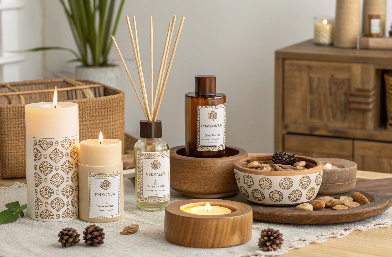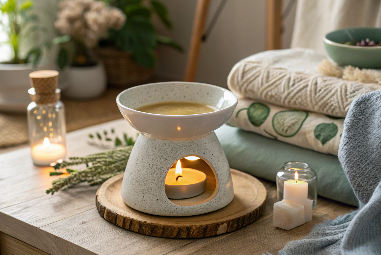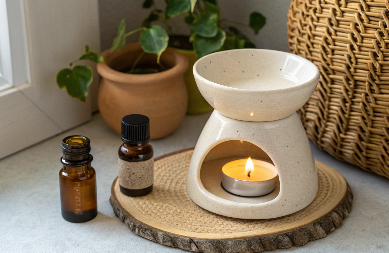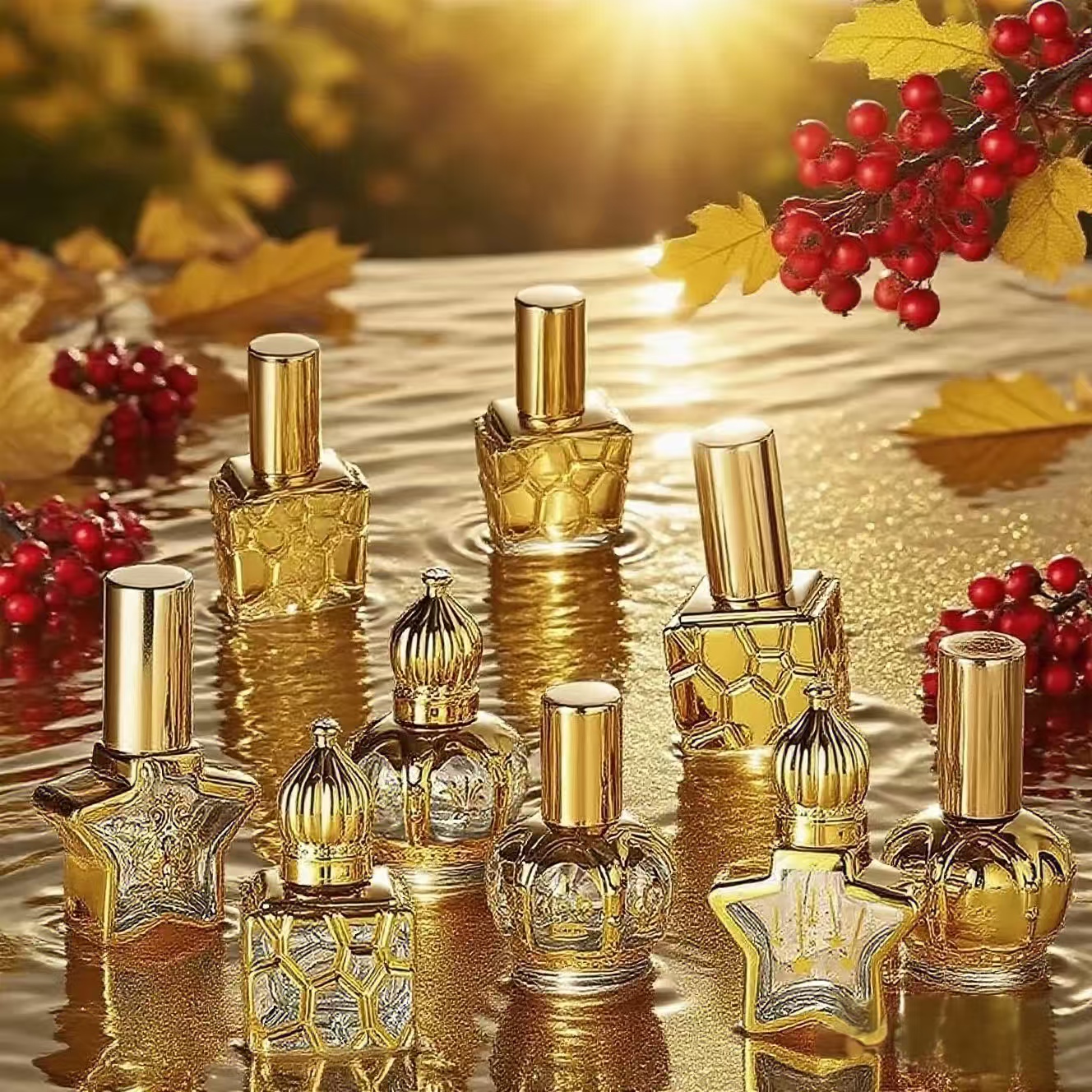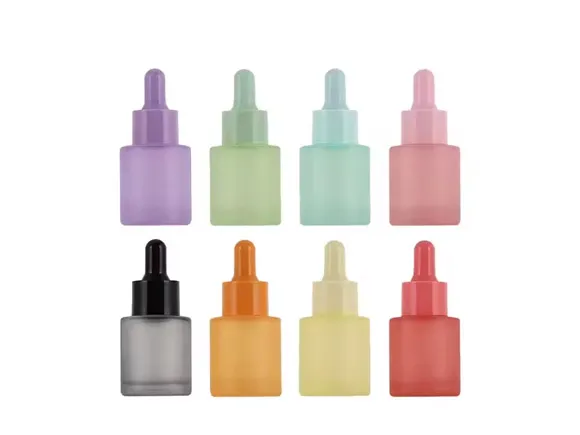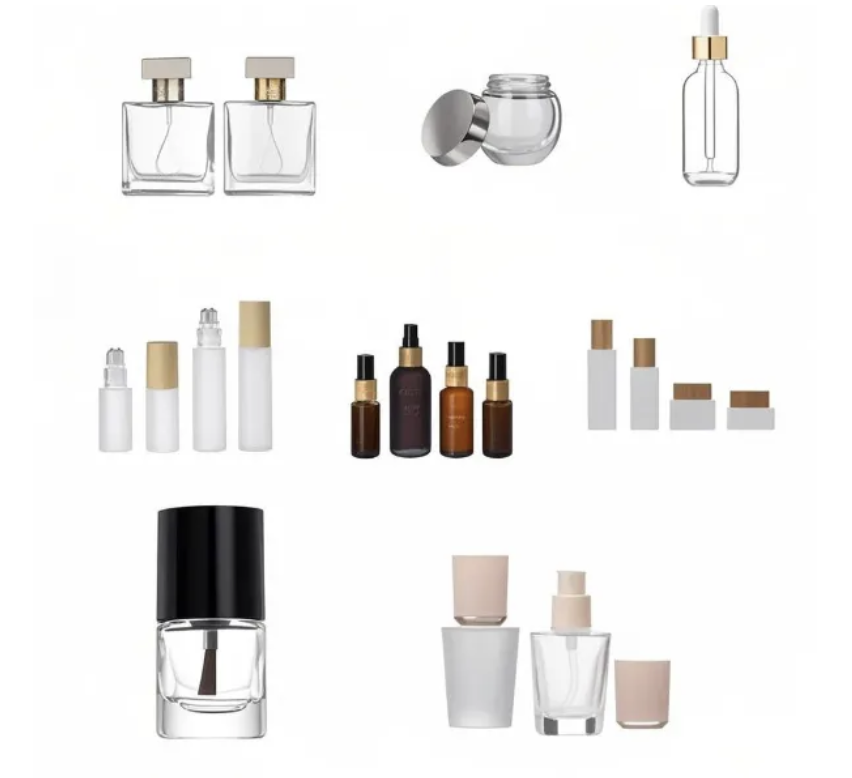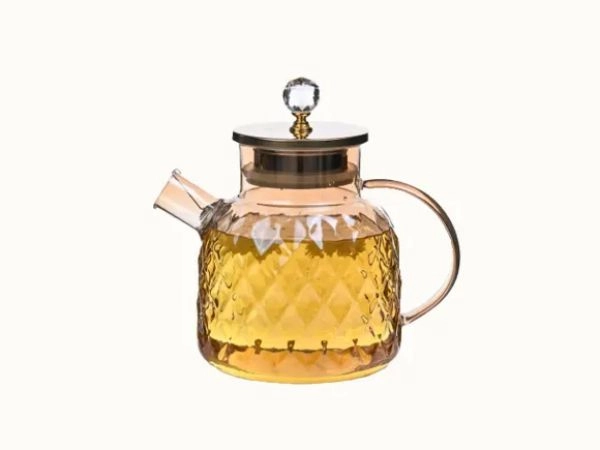The warm glow, the drifting scent—it feels relaxing, but is it safe?
Yes, essential oils can be used in an oil burner, but only with proper precautions: use water as a base, avoid overheating, and never leave it unattended. Overheating oils can reduce their benefits or release irritants.
Oil burners, also known as aroma lamps or ceramic diffusers, are a popular and cost-effective way to enjoy aromatherapy. They work by heating essential oils—often mixed with water—using a small candle or tea light. But while they’re accessible and effective, they also require a bit of care to ensure safety and maintain oil integrity. Here's everything you need to know before you light that flame.
Can I Use Essential Oils in an Oil Burner?
Can You Use Essential Oil Wax Melts in an Oil Burner?
Absolutely! If you’re looking to switch things up or prefer a different method, essential oil wax melts are a fantastic alternative to traditional oils in your burner. Simply place a wax melt in the bowl section of your oil burner (where you’d normally add water and essential oils), and light your tealight beneath.
As the gentle heat melts the wax, it releases a delightful aroma into your space. This method tends to offer a slower, more consistent fragrance, and there’s no need to fuss with water levels or worry about spills. Just be sure to choose melts made specifically for oil burners—those from trusted brands likeYankee CandleorScentsywork best.
Whether you opt for pure oils or wax melts, both can fill your room with inviting, aromatic notes—so feel free to choose whichever fits your mood or setup.
Not only can you—but millions do.
Yes, you can use essential oils in an oil burner, but you must dilute them in water to avoid burning the oil and potentially producing harmful fumes.
Dive Deeper: How to Use an Oil Burner Safely
Handling Stubborn Residue: Cleaning Your Oil Burner
Once your oil burner has cooled completely (safety first!), cleaning is a breeze. Grab a soft, damp cloth and a little washing-up liquid to gently wipe away oily buildup from the bowl. If you find any particularly persistent stains, a paste made from baking soda and a splash of white vinegar works wonders—just let it fizz and gently scrub with a non-abrasive sponge.
Steer clear of metal scouring pads, though—they can scratch or damage your burner’s finish. With a little care, your burner will be ready for your next aromatic adventure!
How Should You Clean and Maintain an Essential Oil Burner?
It's all about keeping things fresh and functional.
To ensure your burner serves you well (and doesn’t acquire a crusty film of yesterday’s lavender), make a habit of cleaning it after each use. Begin by letting it cool down completely—your future self (and fingertips) will thank you.
Wipe away any leftover oil or residue from the bowl using a soft, damp cloth and a bit of mild washing-up liquid. If you encounter stubborn spots that refuse to budge, reach for a bit of baking soda and white vinegar—the classic dynamic duo for household cleaning.
A few extra tips for happy burners:
- Avoid abrasive scourers or metal sponges, which can scratch or damage the surface.
- If there’s lingering scent or residue, let the bowl soak in warm soapy water for a few minutes before wiping clean.
- Be gentle—your oil burner is more fragile than it looks.
Regular maintenance keeps your scents pure and your burner looking its best.
-
Add Water First
-
Fill the dish of your burner with about 1–2 tablespoons of water.
-
-
Add Essential Oils
-
Use 5–10 drops of essential oil depending on room size and scent strength.
-
-
Light the Tea Light Candle
-
Place it under the bowl and allow the flame to gently heat the water-oil mixture.
-
-
Monitor the Burn
-
Don’t let the water evaporate completely. Refill as needed.
-
Never place undiluted essential oil directly on the burner dish.It can overheat, break down chemically, and even become a respiratory irritant.
AtPauPack, we help brands develop ready-to-use essential oil kits for both water-based diffusers and burners. We include clear safety usage instructions and dilution guides with every bottle to ensure both efficacy and customer trust.
Are Essential Oil Burners Safe?
Choosing the Right Material for Your Oil Burner
The material of your essential oil burner plays a big role in both safety and the overall experience. Most burners you'll find are made from ceramic, glass, metal (like copper or brass), or even stone:
-
Ceramic burnersare a favorite for a reason: they distribute heat evenly and tend to stay at safe, manageable temperatures during use. This makes them a practical and popular choice for everyday aromatherapy.
-
Metal burners, on the other hand, such as those made from copper or brass, can heat up quickly and become quite hot to the touch. They're sturdy, but you'll want to handle them with extra care and always place them on a heat-resistant surface.
-
Glass burnersoffer a stylish touch, but require a gentle hand and cautious placement, as they can be more fragile and sometimes struggle with rapid or uneven heating.
-
Stone burners—think carved soapstone—are excellent at retaining warmth, providing slow, sustained diffusion, though they can get heavy.
No matter the material, always pick a stable surface and avoid placing your burner on anything prone to heat damage. For added peace of mind, check that the base is secure and the burner isn’t wobbling before you light up.
Like any flame-based device—only if used correctly.
Essential oil burners are generally safe when used with water, attended while burning, and placed away from children, pets, and flammable materials.
Dive Deeper: Common Safety Guidelines
| Risk | What to Do |
|---|---|
| Fire hazard | Use on a stable, non-flammable surface |
| Overheating oil | Always mix with water |
| Respiratory issues | Avoid synthetic or oxidized oils |
| Burn risk | Keep out of reach of children or pets |
Unlike electric diffusers, oil burners rely on flame—sonever leave them unattended. Also, avoid using oils with strong phenols (like clove or thyme) in small spaces, as they may cause irritation when heated too intensely.
At PauPack, we package essential oils inUV-protective glass bottlesand offermeasured droppersthat help avoid overuse. We also offer client-ready instruction cards for use in aroma lamps, diffusers, or sprays—adding value to every sale.
Precautions When Using Electric Diffusers for Essential Oils
Electric diffusers offer a flameless, user-friendly way to enjoy your favorite scents—but, just like any electrical appliance, a bit of caution goes a long way. Here’s how to stay safe while soaking in those aromatherapeutic vibes:
- Plug Directly Into a Wall Socket:Always plug your diffuser straight into a wall outlet. Avoid extension cords and power strips, which can increase fire risk or cause tripping hazards.
- Unplug When Not in Use:When you’re finished, pull the plug. This isn’t just about safety—unplugging your diffuser helps save energy, too.
- Don’t Overload Sockets:Resist the urge to create a “scented hub” on a single outlet with multiple devices. Overloading can lead to overheating or even electrical fires.
- Keep Away from Water and Humidity:Place your diffuser on a dry, stable surface, and steer clear of sinks, baths, or anywhere splashes might occur—think the bathroom counter after a toddler’s bubble bath adventure.
- Check the Cord and Plug:Inspect regularly for any signs of wear or fraying. If the cord starts to resemble a chew toy more than a cable, swap it out for a new one.
By following these simple practices, you’ll help keep your space fragrant—and hazard-free.
How Long Can You Burn Essential Oils in an Oil Burner?
Burn time should enhance your mood—not overpower it.
You can safely burn essential oils in an oil burner for 30–60 minutes at a time. Longer periods may overheat the oil or lead to irritation.
Dive Deeper: Ideal Usage Duration by Room Size
How Do You Choose the Right Essential Oil Aroma?
Personalization is key—your nose knows best.
Selecting the ideal essential oil aroma isn’t just about scent, but how it aligns with your mood, needs, or wellness goals. Whether you’re seeking calming vibes, focus, or a cheerful pick-me-up, there’s an oil (or blend) for every scenario.
Dive Deeper: Matching Aroma to Intention
- For relaxation or better sleep:Lavender, chamomile, and sandalwood are classics—use these in your evening routine.
- To energize or boost mood:Citrus oils like sweet orange, grapefruit, or lemongrass add brightness to any room. Peppermint or eucalyptus offer a clean, invigorating note.
- For concentration:Rosemary and basil oils can help clarify focus during work or study hours.
- For a cozy, comforting feel:Try blends with cinnamon, clove, or vanilla.
Tips for Tailoring Your Experience
- Start with scent families—floral, citrus, woody, herbal—to see which resonates most.
- Mix and match:Combine 2–3 oils for a customized blend (just test on a blotter strip first).
- Test in small batches:Begin with 1–2 drops when trying a new aroma. Add gradually until you reach the perfect balance for your space.
If you’re new, explore bestseller kits or sample packs from trusted brands likeNOW FoodsorPlant Therapy. Make note of how each oil makes you feel, and keep a small journal of your favorites.
With a little exploration, you’ll curate an aroma toolkit designed for every mood, activity, or season—making your essential oil burner a staple you’ll reach for year-round.
| Room Size | Time Limit | Oil Drops |
|---|---|---|
| Small Room(bedroom) | 30 mins | 5–6 drops |
| Medium Room(living room) | 45 mins | 6–8 drops |
| Large Room(open space) | 60 mins | 8–10 drops |
Tip: Once the scent reaches your preferred intensity, extinguish the candle and enjoy the lingering aroma without continuous burning.
If you're creating a product bundle, consider offering a30ml oil burner blendwith usage suggestions like:
-
"Relax Blend: Burn 30 mins before bedtime"
-
"Mood Boost: 10 drops per hour in large rooms"
PauPack helps brands match scents with recommended burn times and offerspre-designed bottle labelsand blend cards for easy customer education.
Is Heating Essential Oils Safe?
Heat brings scent—but also changes chemistry.
Heating essential oils is generally safe when done gently and with water. However, overheating can degrade the oil’s properties or even release irritating or harmful compounds.
Dive Deeper: Thermal Sensitivity of Oils
Harnessing Aromatherapy: How Eucalyptus, Lavender, and Bergamot Oils Boost Wellness
Let’s unpack how classic essential oils—eucalyptus, lavender, and bergamot—can support your wellbeing when diffused gently in a burner.
Eucalyptus: Cleansing and Clearing
A longtime staple for seasonal sniffles, eucalyptus oil is prized for its fresh, camphorous aroma and clearing properties. When heated gently, eucalyptus can:
- Help promote easier breathing by working as a natural decongestant
- Freshen the air, sharpening focus and providing an invigorating lift
- Add a crisp, spa-like scent to your space—ideal during the cold or allergy seasons
Tip:Use in moderation and avoid overheating, as high temperatures can degrade its therapeutic qualities.
Lavender: Restful Calm
Few oils are as universally adored as lavender. Known for its graceful, floral scent, lavender oil is commonly used to:
- Encourage a sense of relaxation and tranquility
- Soothe feelings of stress and racing thoughts, especially in the evening
- Create a restful environment—simply diffuse before bedtime to help set the mood for sleep
Lavender’s gentle nature also makes it a crowd-pleaser for living rooms, bedrooms, or anywhere a calm ambiance is needed.
Bergamot: Uplifting Balance
With its unique citrus-leafy fragrance, bergamot bridges the gap between energizing and calming. Diffusing bergamot essential oil can:
- Support emotional balance and help manage low moods
- Brighten the atmosphere, offering an uplifting effect without overstimulation
- Infuse your home with a sophisticated scent—a far cry from basic lemon
Remember:For all oils, a gentle approach is key. Use water in your burner and avoid direct, intense heat to get the best from both scent and therapeutic value.
Top Essential Oils for Burners—and What They Bring to Your Space
With so many essential oils to choose from, it can be tough to know where to begin. Here are a few time-tested favorites that pair beautifully with oil burners, and the unique benefits each brings:
Eucalyptus: Breathe Easier
Eucalyptusoil is a classic pick for its crisp, camphoraceous scent and natural ability to clear clogged airways. It’s great during cold season—add a few drops to your burner to create a refreshing, decongestant atmosphere that makes every inhale a little easier. Bonus: its powerful aroma can also help refresh musty rooms.
Lavender: Unwind and Relax
Arguably the world’s most famous essential oil,lavenderis often called upon for its gentle, floral aroma and calming effects. Burn a little before bedtime to encourage relaxation, reduce anxiety, and help settle restless minds. It’s a versatile crowd-pleaser, well suited to bedrooms, living rooms, or anywhere you want a little peace and serenity.
Immune-Boosting Blends: Wellness in the Air
For an added layer of defense, consider blends rich intea tree,lemon, andbergamot. These oils are packed with natural antioxidants and can help support your immune system, especially during times of heightened stress. Diffusing an immune-support blend not only smells bright and uplifting but also signals your body it’s time to rest and recover.
Bergamot: Brighten Your Mood
If you prefer a scent that’s both uplifting and soothing,bergamotis a strong contender. It combines citrusy zest with floral notes, making the air feel lighter and moods more buoyant. Perfect for daytime use,bergamotcan gently boost mental clarity and emotional balance—ideal for work-from-home days or moments requiring a positive reset.
Experiment with these oils to see what resonates with your environment and wellness goals. Always start with a few drops and adjust as needed—many essential oils are potent, and “a little” often goes a long way in a burner.
| Oil Type | Heat Sensitivity | Safe in Burners? |
|---|---|---|
| Citrus Oils | High (oxidize fast) | Yes, with care |
| Resinous Oils | Medium | Yes, use water |
| Mint & Camphor | Medium–High | Use sparingly |
| Thick Oils | Low volatility | May not disperse well |
Heating oils like lemon, eucalyptus, or cinnamon can intensify scent, but also accelerate oxidation. This means the oilloses therapeutic power and becomes less pleasantover time.
That’s why many professionals preferultrasonic diffusersfor regular use, andburners for occasional ambiance.
At PauPack, we help brands decide whichdiffusion method pairs best with which oil blend, offering refill packaging and multi-method diffuser kits to cater to different customer preferences.
Creative Ways to DIY Essential Oil Burners
You don’t need a fancy setup to infuse your space with the scent of bergamot or frankincense—sometimes, all it takes is a few household items and a little resourcefulness. If you’re feeling crafty, here are a few popular and effective DIY methods to burn or heat essential oils at home:
1. The Classic Tealight Jar Burner
- Grab a sturdy glass jar (think: oldBonne Mamanjam or a classicMasonjar).
- Place a tealight candle at the bottom. This becomes your gentle source of heat.
- For the “bowl,” repurpose a metal spoon or a small ceramic ramekin. Bend the handle of the spoon (pliers help here) so it can rest across the rim of the jar, keeping the bowl suspended above the candle flame.
- Add a splash of water and a few drops of your chosen oil to the spoon or dish. Light the candle, and enjoy as the warmth diffuses your custom blend into the room.
2. The Terra Cotta Saucer Touch
- Place a tealight candle inside a heatproof cup or holder.
- Balance a small terra cotta saucer on top—those little ones from gardening stores are perfect.
- Pour water and essential oils into the saucer. The porous clay heats gradually, diffusing fragrance gently—think spa vibes on a shoestring.
3. Make-Do Stove Simmer
- If you don’t mind a little multitasking, add water and a few drops of essential oil to a saucepan.
- Place it on your stove over the absolute lowest heat setting.
- The warmth will lift the aromas into your kitchen (and as a bonus, help humidify dry air).
A little creativity—plus what you already have around the house—lets you experiment safely, cost-effectively, and with the satisfaction of hands-on aromatherapy. Whether you’re upcycling kitchenware or reaching for that rarely-used garden saucer, the point is to explore scent dispersion that feels personal and approachable.
Conclusion
Yes, it is safe to use essential oils in an oil burner—when diluted, attended, and handled responsibly. With the right oil-to-water ratio and time limit, an oil burner can fill your space with scent and calm, creating the perfect aromatherapy moment.




